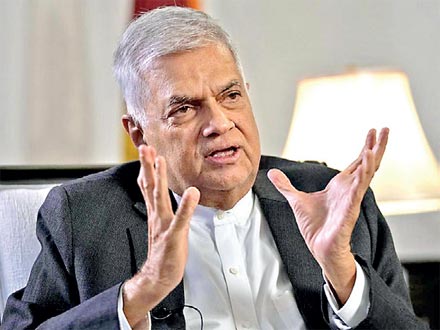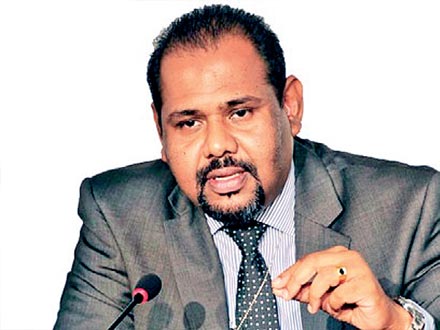Sunday Dec 07, 2025
Sunday Dec 07, 2025
Tuesday, 27 December 2022 00:00 - - {{hitsCtrl.values.hits}}

President Ranil Wickremesinghe

All Ceylon Tamil Congress MP Gajendrakumar Ponnambalam
|

“… A unitary state is one in which ultimate power and authority are concentrated in the institutions of the Central Government, whereas a federal state is one in which such powers are divided and shared between state and sub-state institutions… There has never been universal consensus about these definitions… no abstract definition was able to accurately capture the complexity and variety of constitutional arrangements within countries… it’s silly in the extreme to think that having the words ‘unitary state’ in a piece of paper called the constitution magically protects us from state failure.” – Asanga Welikala, Senior Lecturer in Public Law, University of Edinburgh (Oct 2017)
Gesturing towards opposition benches, in the direction of Tamil politicians, President Ranil Wickremesinghe called on the House to “get together and make it a point to solve this problem by our 75th anniversary of Independence” referring to Sri Lanka’s decades-long project of national reconciliation.
The following week, MP Gajendrakumar Ponnambalam of the All Ceylon Tamil Congress challenged the President further: “Tell the truth to the Sinhala people, that the federal path is the only solution to the ethnic question in Sri Lanka… He should not hesitate to tell that to the Sinhalese people. Federalism is not separation. Quite the contrary.” Jaffna MP M.A. Sumanthiran was quoted in the Hindu of 18 November stating that the President “showed no seriousness to do anything in earnest… we all share the objective of achieving meaningful power devolution under a federal set up”.
If taken at face value, the President’s comments suggest that he is attempting a tried, tested and failed strategy of triangulation; utilising borrowed and thus, temporary political capital to intertwine economic and political solutions; a new ‘grand bargain’ of sorts. On the one hand, President Wickremesinghe’s version of neo-liberal policies that verge on economic libertarianism are contrary to the socio-political formation of the SLPP. Thus far, such inclinations have been begrudgingly accepted by the Parliamentary majority, however the President surely knows that SLPP MPs will be finding it increasingly difficult to return empty-handed to their long-suffering electorates; they will not be satisfied with stories of stability. Under such circumstances, the President can scarcely afford to introduce even more complications to the SLPP’s electoral equation.
The ‘F’ word
While the 2015 ‘Bond Scam’ led to widespread disenchantment with Yahapalanaya during its early months in Government, the Ranil-Maithri (Maithripala Sirisena) axis ultimately collapsed due to:
(1) A slow and stagnant economy as well as a disorganised and splintered administration;
(2) The UNP discourse on reconciliation: explicit overtures to a federal model, co-sponsoring of UNHRC resolution 30/1 of 2015 with its inclusion of foreign judges into a national accountability project
(3) The security failures leading to the Easter attacks.
Once again, Wickremesinghe seems wedded to the very same policy dynamics that led him to points (1) and (2) above. Point (3) may be slightly altered; a security catastrophe is a logical conclusion to the President’s recent promise to deploy the military and quell “unauthorised” protests. During those combative statements, SLPP MPs stared wide-eyed and approvingly at the President’s machismo. Subsequent calls by the President for Tamil MPs to “get together” to solve the National Question left those same colleagues subdued, looking suspicious; the SLPP caucus has traditionally been completely opposed to the Ranilist UNP track on reconciliation.
Indeed the ‘F’ word (federalism) is usually only mentioned in hushed tones in backrooms by some MPs considered to be ‘progressive’ on the issue; but in the past few weeks, the calls for a federal solution have returned to the mainstream discourse, serving up neon-lit warning signs for the Pohottuwa MPs who are all too aware of their diminishing electoral prospects. Is it possible that the SLPP dalliance with Ranil Wickremesinghe might prove to be more damaging for the party than even the catastrophic Gotabaya project?
Ponnambalam also evoked former President Chandrika Kumaratunga (CBK) in his recent comments, specifically her push for a Federal Constitution. His evidence was CBK’s landslide 1994 victory against the UNP. The context of the CBK victory is more complicated than Ponnambalam suggests; the trajectory of the SLFP in the following decade is further proof.
The UNP had been in power for a significant amount of time in the lead up to 1994 and were presiding over a country in the grips of escalating terrorism. The Party had internal ruptures with powerful and popular UNPers Lalith Athulathmudali and Gamini Dissanayake forming a new party and President Ranasinghe Premadasa staving off impeachment. The violence was spilling over into central Colombo, the suburbs, business districts and even religious sites outside the North-East. The assassinations of Athulathmudali and Dissanayake led to the elevation of the latter’s widow, Srima Dissanayake as Presidential candidate. Further, CBK’s was a fascinating candidacy, she was telegenic and youthful with an aristocratic background; an easy sell to the electorate and so, they chose the new, cosmopolitan face of the Sri Lanka Freedom Party.
The SLFP’s liberal turn under CBK would have consequences for the party internally; how did it come to pass that in under a decade, the Bandaranaike’s SLFP would become the party of the Rajapaksas? While CBK was constructing a modern, cosmopolitan platform for the SLFP to reflect a changing electorate, Mahinda Rajapaksa and his contemporaries were generating a fresh movement within the SLFP, one that was true to its left-of-centre and Sinhala-nationalist traditions. While CBK was trying to convince the public of her own plans for the country, the Rajapaksas were coalescing a large majority of Sri Lankans that had found themselves neglected and on the front-lines of a full-blown war against a ruthless terrorist outfit.
Romancing the stone
Ponnambalam and his colleagues must be more precise about their demands; the Sri Lankan Constitution already contains the 13th Amendment which seeks to devolve key powers to the provinces. This does not automatically lead to a federal system but towards a devolution of power within a unitary state with regional governments that are subordinate to the Centre. A federal system or state is a further step forward from devolution within a unitary state, but a step-forward towards what logical conclusion, and does the President possess the political capital to push for full implementation of 13A? Has there ever been a groundswell of support for such a project under Wickremesinghe?
While CBK’s was a platform of neo-liberal economics and federalist constitutions, the mainstream centre of the SLFP base was unconvinced and would find their political home within the Mahinda Rajapaksa-led discourse. The dissatisfaction and distrust of 90’s cosmopolitanism led to the potentially irreversible evolution of the SLFP base that came to define the Rajapaksa movement over the next decade. The story of Sri Lankan politics has since revealed the electorate’s steady rejection of the Rajapaksa alternative, which was always Ranil Wickremesinghe’s UNP.
This trajectory is partly explained by former BBC journalist Mark Salter in a 2015 book regarding the Wickremesinghe/CBK Cease-Fire Agreement and the doomed Norwegian peace project of the early 2000s. Salter quotes Norwegian Peace Envoy Erik Solheim: “Ranil used the term asymmetrical federalism, which is federalism [but] with more powers given to the Tamil Northeast. At this point such a solution would have been acceptable to nearly all Tamils and a vast majority of Sinhalese as well. Then there could have been a referendum: police, land, and other such powers would be given over. And Prabhakaran could have been the Prime Minister of that area.”
This quote from Solheim betrays the source of Wickremesinghe’s enduring unpopularity with the electorate regarding the National Question; an incompatibility between ‘Ranilist Thought’ and the beating heart of the Sri Lankan electorate that has led to the rise of the ultra-nationalist movement and its fealty to the popularity of the Rajapaksas. The President’s current policy path, both economic and socio-political, are more than likely to bring the country full circle; under the clenched fist of ultra-nationalist fervour powered by economic desperation.
The Tiruchelvam track
The late Neelan Tiruchelvam introduced the concept and rationale of federalism within Sri Lanka’s post-colonial context. Part of this definitive thesis and elegant discourse can be found in a chapter he had contributed to ‘Autonomy and Ethnicity: Negotiating Competing Claims in Multi-Ethnic States’ (2000) in the year leading up to his murder.
“…the ideology of the centralized state drew its legitimacy from two distinct sources. On the one hand, the Sinhala ideological construction of the state was linked to the idea that the land, which had certain cosmic characteristics, belonged to the Sinhalese. This was linked to the idea of the Dhamma Deepa, the land in which Theravada Buddhism had been preserved in its pristine purity. On the other hand the dominant colonial constitutional discourse had conceptualized the modern democratic state as one based on the centralization of political and administrative space.”
As Sri Lanka’s leading purveyor of the Federal model, it was Tiruchelvam alongside a certain Prof. Gamini Lakshman Peiris that constructed the basis for CBK’s ‘Union of Regions’ as part of the 1995 program for devolution and constitutional reform which envisioned a post-unitary Sri Lanka, going beyond the 13th Amendment. A BBC article published after Tiruchelvam’s murder notes that “…in one of his last speeches on the need for a new deal for Sri Lanka, Mr. Tiruchelvam warned that even constitutional reform was not enough – instead, politics itself would need to be, in his words, re-imagined, away from the prevailing adversarial culture.”
In an article from August 2021, writer D.B.S. Jeyaraj notes the following views of Lakshman Kadirgamar with regards to federalism: “Kadirgamar was extremely receptive and agreed that federalism would be the ideal solution. But he had reservations on two counts. One was that he felt any realistic solution had to be acceptable to the majority of the Sinhala people as otherwise it would not be implementable. Therefore he opined that the concept of federalism should be avoided and maximum devolution substituted instead. Secondly he said that any settlement had to be on lines acceptable to India. Therefore powers to be devolved to the periphery should not go too much beyond the Centre-State relationship parameters of India…”
In the context of the late Kadirgamar’s comments above, Sri Lanka cannot choose its political structure in a vacuum; an instrument to build a one-way road to reconciliation. The project of national reconciliation must be a two-way street; not only must it encapsulate the island nation’s security and economic interests and regional relationships but it must also recruit a large and diverse majority of Sri Lankans. This is the only way such reconciliation becomes sustainable; able to withstand the next ultra-nationalist wave that will arrive sooner than we think.
(The writer could be reached via email at [email protected] or Twitter: @kusumw.)